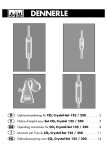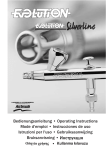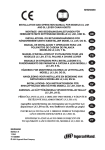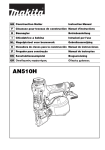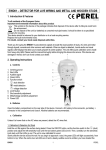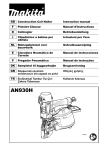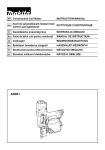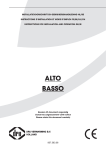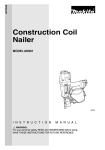Download GB Pneumatic Framing Nailer Instruction Manual F
Transcript
GB Pneumatic Framing Nailer F Cloueuse pneumatique sur cadre NL Pneumatische nagelaandrijver AN942 Instruction Manual Manuel d’instructions Gebruiksaanwijzing ) .3 (5 0. 4 53 0.8 3( 0.6 8.3) 4(6 .4) (CFM) ) .4 3 4 4( 4 0. 1 2 2 1 0 10 20 30 40 50 2 1 3 3 4 5 6 4 5 7 9 8 6 2 7 10 8 9 11 12 13 10 14 11 15 16 12 13 17 18 19 20 14 15 3 1 21 25 22 26 23 24 16 17 18 19 20 21 27 28 22 4 23 1617 29 24 25 30 31 32 26 27 28 5 Symbols The followings show the symbols used for the tool. Be sure that you understand their meaning before use. Symboles Nous donnons ci-dessous les symboles utilisés pour l’outil. Assurez-vous que vous en avez bien compris la signification avant d’utiliser l’outil. Symbolen Voor dit gereedschap worden de volgende symbolen gebruikt. Zorg ervoor dat u de betekenis van deze symbolen begrijpt alvorens het gereedschap te gebruiken. ❏ Read instruction manual. ❏ Lire le mode d’emploi. ❏ Lees de gebruiksaanwijzing. ❏ Wear safety glasses. ❏ Porter des lunettes de protection. ❏ Draag een veiligheidsbril. 6 ENGLISH Explanation of general view 1 Compressor air output per minute 2 Nailing frequency (times/min.) 3 Pneumatic tool oil 4 Holder 5 Nose adapter 6 Magazine 7 Contact arm 8 Nose adapter 9 Adjuster 10 Pusher 11 12 13 14 15 16 17 18 19 20 21 Pusher lever Depress Return Nail stopper Air socket Air fitting Continuos nailing Intermittent nailing Change lever Trigger lock Hammer SPECIFICATIONS Model AN942 Air pressure .................. 0.44 – 0.83 Mpa (4.4 – 8.3 bar) Nail Iength ..............................................50 mm – 90 mm Nail capacity ................................................ 60 – 84 pcs. Dimensions (L x H x W) .... 446 mm x 376 mm x 108 mm Min. hose diameter .............................................. 8.5 mm Net weight ..............................................................3.8 kg • Due to our continuing program of research and development, the specifications herein are subject to change without notice. • Note: Specifications may differ from country to country. Power supply The tool should be connected only to a power supply of the same voltage as indicated on the nameplate, and can only be operated on single-phase AC supply. They are double-insulated in accordance with European Standard and can, therefore, also be used from sockets without earth wire. Safety hints For your own safety, please refer to the enclosed safety instructions. IMPORTANT SAFETY INSTRUCTIONS ENB067-1 WARNING: WHEN USING THIS TOOL, BASIC SAFETY PRECAUTIONS SHOULD ALWAYS BE FOLLOWED TO REDUCE THE RISK OF PERSONAL INJURY, INCLUDING THE FOLLOWING: READ ALL INSTRUCTIONS. • For personal safety and proper operation and maintenance of the tool, read this instruction manual before using the tool. • Always wear safety glasses to protect your eyes from dust or nail injury. WARNING: It is an employer’s responsibility to enforce the use of safety eye protection equipment by the tool operators and by other persons in the immediate working area. • Wear hearing protection to protect your ears against exhaust noise and head protection. Also wear light but not loose clothing. Sleeves should be buttoned or rolled up. No necktie should be worn. 22 23 24 25 26 27 28 29 30 31 32 Small rod Ejection port Driver Pliers Slot Change lever Trigger lock Drain cock Air filter Oiler Pneumatic oil • Rushing the job or forcing the tool is dangerous. Handle the tool carefully. Do not operate when under the influence of alcohol, drugs or the like. General Tool Handling Guidelines: 1. Always assume that the tool contains fasteners. 2. Do not point the tool toward yourself or anyone whether it contains fasteners or not. 3. Do not activate the tool unless the tool is placed firmly against the workpiece. 4. Respect the tool as a working implement. 5. No horseplay. 6. Do not hold or carry the tool with a finger on the trigger. 7. Do not load the tool with fasteners when any one of the operating controls is activated. 8. Do not operate the tool with any power source other than that specified in the tool operating/ safety instructions. • An improperly functioning tool must not be used. • Sparks sometimes fly when the tool is used. Do not use the tool near volatile, flammable materials such as gasoline, thinner, paint, gas, adhesives, etc.; they will ignite and explode, causing serious injury. • The area should be sufficiently illuminated to assure safe operations. The area should be clear and litter-free. Be especially careful to maintain good footing and balance. • Only those involved in the work should be in the vicinity. Children especially must be kept away at all times. • There may be local regulations concerning noise which must be complied with by keeping noise levels within prescribed limits. In certain cases, shutters should be used to contain noise. • Do not play with the contact element: it prevents accidental discharge, so it must be kept on and not removed. Securing the trigger in the ON position is also very dangerous. Never attempt to fasten the trigger. Do not operate a tool if any portion of the tool operating controls is inoperable, disconnected, altered, or not working properly. • Operate the tool within the specified air pressure of 0.44 – 0.83 MPa (4.4 – 8.3 bar) for safety and longer tool life. Do not exceed the recommended max. operating pressure of 0.83 MPa (8.3 bar). The tool should not be connected to a source whose pressure potentially exceeds 1.37 MPa (13.7 bar). 7 • Make sure that the pressure supplied by the compressed air system does not exceed the maximum allowable pressure of the fastener driving tool. Set the air pressure initially to the lower value of the recommended allowable pressure (see SPECIFICATIONS). • Never use the tool with other than compressed air. If bottled gas (carbon dioxide, oxygen, nitrogen, hydrogen, air, etc.) or combustible gas (hydrogen, propane, acetylene, etc.) is used as a power source for this tool, the tool will explode and cause serious injury. • Always check the tool for its overall condition and loose screws before operation. Tighten as required. • Make sure all safety systems are in working order before operation. The tool must not operate if only the trigger is pulled or if only the contact arm is pressed against the wood. It must work only when both actions are performed. Test for possible faulty operation with nails unloaded and the pusher in fully pulled position. • Make sure that the trigger is locked when the change lever is set to the LOCK position. • Check walls, ceilings, floors, roofing and the like carefully to avoid possible electrical shock, gas leakage, explosions, etc. caused by striking live wires, conduits or gas pipes. • Use only nails specified in this manual. • The use of any other nails may cause malfunction of the tool. • Never use fastener driving tools marked with the symbol “Do not use on scaffoldings, ladders” for specific application for example: - when changing one driving location to another involves the use of scaffoldings, stairs, ladders, or ladder alike constructions, e.g. roof laths; - closing boxes or crates; - fitting transportation safety systems e.g. on vehicles and wagons. • Do not permit those uninstructed to use the tool. • Make sure no one is nearby before nailing. Never attempt to nail from both the inside and outside at the same time. Nails may rip through and/or fly off, presenting a grave danger. • Watch your footing and maintain your balance with the tool. Make sure there is no one below when working in high locations, and secure the air hose to prevent danger if there is sudden jerking or catching. • On rooftops and other high locations, nail as you move forward. It is easy to lose your footing if you nail while inching backward. When nailing against perpendicular surface, nail from the top to the bottom. You can perform nailing operations with less fatigue by doing so. • A nail will be bent or the tool can become jammed if you mistakenly nail on top of another nail or strike a knot in the wood. The nail may be thrown and hit someone, or the tool itself can react dangerously. Place the nails with care. 8 • Do not leave the loaded tool or the air compressor under pressure for a long time out in the sun. Be sure that dust, sand, chips and foreign matter will not enter the tool in the place where you leave it setting. • Do not point the ejection port at anyone in the vicinity. Keep hands and feet away from the ejection port area. • When the air hose is connected, do not carry the tool with your finger on the trigger or hand it to someone in this condition. Accidental firing can be extremely dangerous. • Handle the tool carefully, as there is high pressure inside the tool that can be dangerous if a crack is caused by rough handling (dropping or striking). Do not attempt to carve or engrave on the tool. • Stop nailing operations immediately if you notice something wrong or out of the ordinary with the tool. • Always disconnect the air hose and remove all of the nails: 1. When unattended. 2. Before performing any maintenance or repair. 3. Before cleaning a jam. 4. Before moving the tool to a new location. • Perform cleaning and maintenance right after finishing the job. Keep the tool in tip-top condition. Lubricate moving parts to prevent rusting and minimize friction-related wear. Wipe off all dust from the parts. • When not operating the tool, always lock the trigger by turning the change lever to the LOCK position. • Do not operate this tool if it does not contain a legible WARNING LABEL. • Do not modify tool without authorization from Makita. • Ask Makita’s Authorized service centers for periodical inspection of the tool. • To maintain product SAFETY and RELIABILITY, maintenance and repairs should be performed by Makita Authorized Service Centers, always using Makita replacement parts. SAVE THESE INSTRUCTIONS. INSTALLATION Selecting compressor (Fig. 1) Select a compressor that has ample pressure and air output to assure cost-efficient operation. The graph shows the relation between nailing frequency, applicable pressure and compressor air output. Thus, for example, if nailing takes place at a rate of approximately 40 times per minute at a compression of 0.59 MPa (5.9 bar), a compressor with an air output over 3 CFM (ft3/minute) is required. Pressure regulators must be used to limit air pressure to the rated pressure of the tool where air supply pressure exceeds the tool’s rated pressure. Failure to do so may result in serious injury to tool operator or persons in the vicinity. Selecting air hose (Fig. 2) Use an air hose as large and as short as possible to assure continuous, efficient nailing operation. With an air pressure of 0.49 MPa (4.9 bar), an air hose with an internal diameter of over 8.5 mm (5/16") and a length of less than 20 m (6.6 ft.) is recommended when the interval between each nailing is 0.5 seconds. Air supply hoses shall have a minimum working pressure rating of 1.03 MPa (10.3 bar) or 150 percent of the maximum pressure produced in the system whichever is higher. CAUTION: • Low air output of the compressor, or a long or smaller diameter air hose in relation to the nailing frequency may cause a decrease in the driving capability of the tool. Lubrication (Fig. 3 & 4) To insure maximum performance, install an air set (oiler, regulator, air filter) as close as possible to the tool. Adjust the oiler so that one drop of oil will be provided for every 30 nails. When an air set is not used, oil the tool with pneumatic tool oil by placing 2 (two) or 3 (three) drops into the air fitting. This should be done before and after use. For proper lubrication, the tool must be fired a couple of times after pneumatic tool oil is introduced. FUNCTIONAL DESCRIPTION Nose adapter (Fig. 5 & 6) CAUTION: • Always lock the trigger and disconnect the hose before installing or removing the nose adapter. When nailing workpieces with easily-marred surfaces, use the nose adapter. It is stored in the holder on the reverse side of the magazine. Attach the nose adapter to the contact arm. When not in use, store the nose adapter in the holder on the reverse side of the magazine to keep it from being lost. Adjusting depth of nailing (Fig. 7) CAUTION: • Always lock the trigger and disconnect the hose before adjusting the depth of nailing. To adjust the depth of nailing, turn the adjuster so that the arrow above the adjuster will point to the number indicated on the adjuster. The depth of nailing is the deepest when the arrow points to the number 1. It will become shallower as the arrow points to higher number. The depth can be changed in approx. 1.0 mm increments per graduation. If nails cannot be driven deep enough even when the arrow points to the number 1, increase the air pressure. If nails are driven too deep even when the arrow points to the number 9, decrease the air pressure. Generally speaking, the tool service life will be longer when the tool is used with lower air pressure and the adjuster set to a lower number. ASSEMBLY Loading nailer (Fig. 8 & 9) CAUTION: • Always lock the trigger and disconnect the hose before loading the nailer. Select nails suitable for your work. Insert strip of nails into the magazine. Pull the pusher lever to the rear to engage the pusher to the last nail. Unloading nailer (Fig. 10 & 11) CAUTION: • Always disconnect the air hose before unloading the nailer. Pull the pusher lever to the rear. Return the pusher lever back while keeping the pusher depressed to disengage it from the strip of nails. Depress the nail stopper and remove the strip of nails from the magazine. Connecting air hose (Fig. 12) Lock the trigger. Slip the air socket of the air hose onto the air fitting on the nailer. Be sure that the air socket locks firmly into position when installed onto the air fitting. A hose coupling must be installed on or near the tool in such a way that the pressure reservoir will discharge at the time the air supply coupling is disconnected. OPERATION CAUTION: • Make sure all safety systems are in working order before operation. 1. 2. To drive a nail, you may place the contact element against the workpiece and pull the trigger (Fig. 13), or Pull the trigger first and then place the contact element against the workpiece. (Fig. 14) However when the tool is set to the “Intermittent Nailing” mode, WITH THE TRIGGER HELD IN A HALF-PULLED POSITION, an unexpected nailing could occur, if the contact element is allowed to re-contact against the workpiece or the other surface under the influence of recoil. In order to avoid this unexpected nailing, perform as follows; 1. Do not place the contact element against the workpiece with excessive force. 2. Pull the trigger fully and hold it on for 1 – 2 seconds after nailing. No. 1 method is for intermittent nailing, when you wish to drive a nail carefully and very accurately. No. 2 method is for continuous nailing. For No. 1 method, set the change lever to the “Intermittent Nailing” position. For No. 2 method, set the change lever to the “Continuous Nailing” position. Before using the change lever to change the nailing method, always make sure that the change lever is properly set to the position for the desired nailing method. (Fig. 15) Anti dry fire mechanism This tool is equipped with an anti dry fire mechanism. When there are a few nails remaining in the magazine, the contact arm will be locked in the undepressed position to prevent the tool from being activated. Load more nails to resume operation. 9 Jammed nailer (Fig. 16 & 17) CAUTION: • Always lock the trigger, disconnect the hose and remove the nails from the magazine before cleaning a jam. When the nailer becomes jammed, do as follows: Insert a small rod or the like into the ejection port and tap it with a hammer to retract the driver. Use pliers to bend the jammed nail so that the nail head comes out of the slot in the driver guide. Then remove the jammed nail. Nails (Fig. 18 & 19) Handle nail strips and their box carefully. If the nail strips have been handled roughly, they may be out of shape or their connector breaks, causing poor nail feed. Avoid storing nails in a very humid or hot place or place exposed to direct sunlight. Noise and Vibration ENG006-1 The typical A-weighted noise levels are sound pressure level: 89 dB (A) sound power level: 102 dB (A) – Wear ear protection. – The typical weighted root mean square acceleration value is 4 m/s2. EC-DECLARATION OF CONFORMITY We declare under our sole responsibility that this product is in compliance with the following standards of standardized documents, EN792 in accordance with Council Directives, 98/37/EC. Yasuhiko Kanzaki CE 2003 MAINTENANCE CAUTION: • Always disconnect the hose before attempting to perform inspection or maintenance. Maintenance of nailer Always check the tool for its overall condition and loose screws before operation. Tighten as required. (Fig. 20) With tool disconnected, make daily inspection to assure free movement of the contact element and trigger. Do not use tool if the contact element or trigger sticks or binds. (Fig. 21) Make sure that the trigger is locked when the change lever is set to the LOCK position. (Fig. 22) When the tool is not to be used for an extended period of time, lubricate the tool using pneumatic tool oil and store the tool in a safe place. Avoid exposure to direct sunlight and/or humid or hot environment. (Fig. 23 & 24) Maintenance of compressor, air set and air hose After operation, always drain the compressor tank and the air filter. If moisture is allowed to enter the tool, It may result in poor performance and possible tool failure. (Fig. 25 & 26) Check regularly to see if there is sufficient pneumatic oil in the oiler of the air set. Failure to maintain sufficient lubrication will cause O-rings to wear quickly. (Fig. 27) Keep the air hose away from heat (over 60°C, over 140°F), away from chemicals (thinner, strong acids or alkalis). Also, route the hose away from obstacles which it may become dangerously caught on during operation. Hoses must also be directed away from sharp edges and areas which may lead to damage or abrasion to the hose. (Fig. 28) To maintain product SAFETY and RELIABILITY, repairs, any other maintenance or adjustment should be performed by Makita Authorized Service Centers, always using Makita replacement parts. 10 Director MAKITA INTERNATIONAL EUROPE LTD. Michigan Drive, Tongwell, Milton Keynes, Bucks MK15 8JD, ENGLAND FRANÇAIS Descriptif 1 Sortie d’air du compresseur par minute 2 Fréquence de clouage (clous/ min) 3 Huile pour outil pneumatique 4 Support 5 Adaptateur de bec 6 Magasin 7 Bras de contact 8 Adaptateur de bec 9 Dispositif de réglage 10 Pousseur 11 12 13 14 15 16 17 18 19 20 21 22 Levier du pousseur Appuyer Rabattre Butée à clou Douille à air Raccord à air Clouage continu Clouage intermittent Levier de changement de mode Verrou de la gâchette Marteau Petite tige métallique SPÉCIFICATIONS Modèle AN942 Pression d’air ................ 0,44 – 0,83 Mpa (4,4 – 8,3 bar) Longueur de clou....................................50 mm – 90 mm Capacité de clouage .................................... 60 – 84 pcs. Dimensions (L x H x P) ..... 446 mm x 376 mm x 108 mm Diamètre minimal du tuyau .................................. 8,5 mm Poids net ................................................................3,8 kg • Etant donné l’évolution constante de notre programme de recherche et de développement, les spécifications contenues dans ce manuel sont sujettes à modification sans préavis. • Note : Les spécifications peuvent varier suivant les pays. Alimentation L’outil ne devra être raccordé qu’à une alimentation de la même tension que celle qui figure sur la plaque signalétique, et il ne pourra fonctionner que sur un courant secteur monophasé. Réalisé avec une double isolation, il est conforme à la réglementation européenne et peut de ce fait être alimenté sans mise à la terre. Consignes de sécurité Pour votre propre sécurité, reportez-vous aux consignes de sécurité qui accompagnent l’outil. CONSIGNES DE SÉCURITÉ IMPORTANTES MISE EN GARDE : PAR MESURE DE SÉCURITÉ, DES PRÉCAUTIONS DE BASE DOIVENT ÊTRE PRISES LORS DE L’UTILISATION DE CET OUTIL, AFIN DE RÉDUIRE LES RISQUES DE BLESSURE. CES MESURES COMPRENNENT LES SUIVANTES : LISEZ TOUTES LES INSTRUCTIONS. • Par mesure de sécurité personnelle et pour assurer une utilisation et un entretien adéquat, veuillez lire ce manuel d’instructions avant d’utiliser l’outil. • Portez toujours des lunettes de sécurité pour protéger vos yeux contre toute blessure au contact de la poussière ou d’un clou. MISE EN GARDE : L’employeur a la responsabilité d’imposer le port d’un dispositif de protection des yeux aux utilisateurs des outils et à toute personne présente dans l’aire de travail. 23 24 25 26 27 28 29 30 31 32 Orifice d’éjection Dispositif d’entraînement Pince Fente Levier de changement de mode Verrou de la gâchette Robinet de vidange Filtre à air Réservoir d’huile Huile à outil pneumatique • Portez une protection d’oreilles pour les protéger contre le bruit, et portez un casque de sécurité. Les vêtements portés doivent être légers et ne doivent pas être amples. Veuillez boutonner ou rouler vos manches. Ne portez pas de cravate. • Il est dangereux de travailler trop vite ou d’appliquer une charge de travail excessive à l’outil. Manipulez l’outil avec soin. N’utilisez pas l’outil si vous avez consommé de l’alcool, des médicaments, etc. Conseils généraux pour l’utilisation des outils : 1. Gardez toujours à l’esprit que l’outil contient des clous. 2. L’outil ne doit jamais être pointé vers vous-même ou vers une autre personne, qu’il contienne ou non des clous. 3. Ne mettez pas l’outil en marche avant qu’il ne soit fermement placé sur la pièce à travailler. 4. Respectez votre outil en tant qu’instrument de travail. 5. Évitez tout chahut. 6. L’outil ne doit jamais être saisi ou transporté en posant un doigt sur la gâchette. 7. Ne mettez jamais de clous dans l’outil alors que l’une de ses commandes est activée. 8. Ne branchez jamais l’outil sur une source d’alimentation autre que celle spécifiée dans les instructions d’utilisation et consignes de sécurité qui l’accompagnent. • Tout outil défectueux ne doit pas être utilisé. • Des étincelles s’échappent parfois de l’outil pendant son utilisation. N’utilisez pas l’outil près de substances ou matériaux volatiles ou inflammables tels que l’essence, le diluant, la peinture, le gaz, les adhésifs, etc. Ils risqueraient de prendre feu, d’exploser et de causer une blessure grave. • L’aire de travail doit être suffisamment éclairée pour assurer la sécurité du travail. L’aire de travail doit être maintenue propre et exempte de déchets. Prenez particulièrement soin de maintenir une bonne prise au sol et une bonne position d’équilibre. • Seules les personnes qui participent au travail doivent pénétrer dans l’aire de travail. Les enfants, tout particulièrement, doivent être maintenus à l’écart en tout temps. 11 • Il se peut que des réglementations locales s’appliquent concernant les niveaux de bruit permis. Veuillez les respecter. Le cas échéant, des volets doivent être installés pour réduire le bruit. • Ne modifiez pas l’élément de contact. Il permet de prévenir toute décharge accidentelle et doit donc être laissé en place. Il est également très dangereux de fixer la gâchette en position de marche. Il ne faut jamais essayer d’immobiliser la gâchette. N’utilisez jamais un outil dont une des commandes est inutilisable, déconnectée, modifiée ou ne fonctionne pas correctement. • Par mesure de précaution et pour augmenter la durée de vie de l’outil, réglez-le toujours à l’intérieur de la plage de pression d’air spécifiée, de 0,44 à 0,83 MPa (4,4 à 8,3 bar). Ne dépassez jamais la pression maximale recommandée de 0,83 MPa (8,3 bar). L’outil ne doit pas être raccordé à une source dont la pression peut dépasser 1,37 MPa (13,7 bar). • Assurez-vous que la pression fournie par le système d’air comprimé ne dépasse pas la pression maximale permise de la cloueuse. Réglez d’abord la pression d’air sur la plus petite valeur de pression recommandée (voir SPÉCIFICATIONS). • Cet outil doit être exclusivement utilisé avec de l’air comprimé. L’utilisation d’une bouteille de gaz (dioxyde de carbone, oxygène, nitrogène, hydrogène, air, etc.) ou de gaz combustible (hydrogène, propane, acétylène, etc.) comme source de pression de cet outil entraînera une explosion et risque de causer une blessure grave. • Avant d’utiliser l’outil, assurez-vous qu’il est en bon état et qu’aucune de ses vis n’est desserrée. Le cas échéant, serrez les vis. • Assurez-vous que tous les dispositifs de sécurité sont en état de fonctionner avant d’utiliser l’outil. En principe cet outil ne fonctionne pas si vous appuyez seulement sur la gâchette ou si vous appuyez simplement le bras de contact contre le bois. Il est nécessaire que ces deux actions soient exécutées pour que l’outil fonctionne. Retirez les clous de l’outil et tirez le pousseur à fond pour vérifier l’absence de tout vice de fonctionnement. • Assurez-vous que la gâchette est verrouillée lorsque vous réglez le levier de changement de mode en position LOCK. • Pour éviter tout risque de choc électrique, de fuite de gaz, d’explosion, etc., provoqué par le contact avec des fils dénudés, des conduites ou des tuyaux de gaz, vérifiez le mur, le plafond, le plancher, le toit ou toute autre pièce où vous clouez. • Utilisez uniquement les clous spécifiés dans ce manuel. • L’outil risque de mal fonctionner si vous utilisez tout autre type de clou. • Il ne faut jamais utiliser les outils de clouage qui portent l’indication “Do not use on scaffoldings, ladders” dans des situations suivantes : - lorsqu’il faut utiliser un échafaudage, un escalier, une échelle, etc. ; - pour poser des clous sur des lattes de toit ; - pour fermer des boîtes ou des caisses, ou ; 12 • • • • • • • • • • • - pour installer des dispositifs de sécurité sur un véhicule ou un wagon. Seules les personnes ayant pris connaissance du fonctionnement de l’outil doivent être autorisées à l’utiliser. Avant de procéder au clouage, assurez-vous que personne ne se trouve près de vous. N’essayez jamais de clouer une pièce en même temps des côtés intérieur et extérieur. Cela est très dangereux, puisque les clous risquent alors de défoncer la pièce ou d’être projetés. Regardez où vous posez les pieds et assurez-vous d’un bon équilibre pendant l’utilisation de l’outil. Assurez-vous qu’il n’y a personne sous vous lorsque vous travaillez dans un endroit élevé, et fixez le tuyau d’air de sorte qu’il ne risque pas de se détacher s’il est secoué ou s’il se coince. Sur les toits et autres endroits élevés, clouez en vous déplaçant vers l’avant. Vous risquez de perdre pied si vous clouez en vous déplaçant à reculons. Lorsque vous clouez sur une surface horizontale, faites-le du haut vers le bas. De cette façon le travail de clouage sera moins exigeant physiquement. Le clou risque de se plier ou l’outil de se bloquer si vous clouez par inadvertance dans un nœud ou sur un autre clou. Le clou risque alors d’être projeté et de frapper quelqu’un, ou bien l’outil lui-même risque de réagir de manière dangereuse. Choisissez l’emplacement des clous avec soin. N’abandonnez pas pour une période prolongée un outil chargé ou un compresseur d’air sous pression exposé au soleil à l’extérieur. Assurez-vous de toujours déposer l’outil en un endroit où la poussière, le sable, les copeaux et corps étrangers ne risquent pas d’y pénétrer. Ne pointez jamais la sortie d’éjection vers une personne se trouvant à proximité. Gardez les mains et les pieds à l’écart de la zone de la sortie d’éjection. Pour transporter l’outil ou le donner à quelqu’un alors que le tuyau d’air est raccordé, ne posez pas le doigt sur la gâchette. Le déclenchement accidentel de l’outil peut être extrêmement dangereux. Manipulez l’outil prudemment. La pression élevée à l’intérieur de l’outil représente un danger si une fissure est provoquée par un manipulation brusque (laisser tomber l’outil ou le frapper). Ne tentez jamais de tailler ou graver une inscription sur l’outil. Cessez immédiatement le clouage si vous notez une anomalie ou un fonctionnement inhabituel de l’outil. Déconnectez toujours le tuyau d’air et retirez tous les clous dans les cas suivants : 1. Lorsque l’outil est abandonné sans surveillance. 2. Avant d’effectuer tout travail d’entretien ou de réparation sur l’outil. 3. Avant de réparer un blocage. 4. Avant de déplacer l’outil vers un autre lieu. • Procédez au nettoyage et à l’entretien de l’outil une fois le travail terminé. Maintenez l’outil en excellente condition. Lubrifiez les pièces mobiles pour éviter qu’elles ne rouillent et pour limiter l’usure entraînée par la friction. Retirez toute poussière déposée sur les pièces. • Lorsque vous n’utilisez pas l’outil, verrouillez toujours la gâchette en tournant le levier de changement de mode sur la position VERROUILLAGE. • N’utilisez pas cet outil si aucune ÉTIQUETTE D’AVERTISSEMENT lisible n’y est apposée. • Ne modifiez pas l’outil sans l’autorisation de Makita. • Confiez régulièrement l’outil à un centre de service après-vente agréé Makita pour une inspection. • Pour maintenir la SÉCURITÉ et la FIABILITÉ du produit, son entretien et sa réparation doivent être effectués dans un centre de service après-vente agréé Makita, exclusivement avec des pièces de rechange Makita. CONSERVEZ CES INSTRUCTIONS. INSTALLATION Sélection du compresseur (Fig. 1) Choisissez un compresseur dont la capacité de pressurisation et de sortie d’air assurera un bon rapport qualité/ coût. Le graphique indique la relation entre la fréquence de clouage, la pression applicable et la sortie d’air du compresseur. Ainsi, par exemple, un clouage à raison d’environ 40 clous par minute avec une pression de 0,59 MPa (5,9 bar) nécessite une sortie d’air supérieure à 3 pi³/min. Un régulateur de pression doit être utilisé si la pression d’air fournie dépasse la capacité nominale de l’outil. Autrement, l’utilisateur et les personnes présentes courent un risque de blessure grave. Sélection du tuyau d’air (Fig. 2) Le tuyau d’air utilisé doit être le plus large et le plus court possible, pour assurer un travail de clouage continu et efficace. Avec une pression d’air de 0,49 MPa (4,9 bar), nous recommandons tuyau d’air d’un diamètre interne supérieur à 8,5 mm (5/6 po) et d’une longueur inférieure à 20 m (6,6 pi) pour un intervalle de 0,5 seconde entre chaque clou. Les tuyaux d’adduction d’air doivent avoir une pression de service minimale de 1,03 MPa (10,3 bar) ou de 1,5 fois la pression maximale produite par le système, la valeur la plus élevée parmi les précédentes s’appliquant. Lubrification (Fig. 3 et 4) Pour assurer une performance maximale, installez une chambre à air (qui contient le réservoir d’huile, le régulateur et le filtre à air) le plus près possible de l’outil. Ajustez le réservoir d’huile de sorte qu’une goutte d’huile soit fournie à intervalles de 30 clous. Si vous n’utilisez pas de chambre à air, graissez l’outil en versant deux (2) ou trois (3) gouttes d’huile pour outil pneumatique dans le raccord à air. Cette opération doit être effectuée avant et après l’utilisation. Pour assurer une lubrification adéquate, il faut faire déclencher l’outil à quelques reprises après l’insertion de l’huile pour outil pneumatique. DESCRIPTION DU FONCTIONNEMENT Adaptateur de bec (Fig. 5 et 6) ATTENTION : • Verrouillez toujours la gâchette et déconnectez le tuyau avant d’installer ou de retirer l’adaptateur de bec. Utilisez l’adaptateur de bec pour clouer dans des pièces dont la surface s’abîme facilement. Il est rangé dans le support qui se trouve de l’autre côté du magasin. Fixez l’adaptateur de bec sur le bras de contact. Lorsque vous n’utilisez pas le bec, rangez-le dans le support qui se trouve de l’autre côté du magasin, pour éviter de le perdre. Réglage de la profondeur de clouage (Fig. 7) ATTENTION : • Verrouillez toujours la gâchette et déconnectez le tuyau avant de régler la profondeur de clouage. Pour régler la profondeur de clouage, tournez la bague de réglage de sorte que la flèche qui se trouve au-dessus de la bague pointe sur un des chiffres indiqués sur la bague. La profondeur de clouage est maximale lorsque la flèche pointe sur le chiffre 1. Plus la flèche pointe sur un chiffre élevé, plus la profondeur diminue. La modification de la profondeur s’effectue par pas d’environ 1,0 mm. Si les clous ne s’enfoncent pas assez profondément même lorsque la flèche pointe sur le chiffre 1, augmentez la pression d’air. Si les clous s’enfoncent trop profondément même lorsque la flèche pointe sur le chiffre 9, réduisez la pression d’air. En général, la durée de service de l’outil est plus longue s’il est utilisé avec une faible pression d’air et avec la bague de réglage placée sur un chiffre peu élevé. ATTENTION : • La capacité d’entraînement de l’outil risque de diminuer si la sortie d’air du compresseur est faible ou si le tuyau d’air est trop long ou d’un diamètre trop petit pour la fréquence de clouage. 13 ASSEMBLAGE Chargement de la cloueuse (Fig. 8 et 9) ATTENTION : • Verrouillez toujours la gâchette et déconnectez le tuyau avant de charger la cloueuse. Choisissez des clous qui conviennent au type de travail à effectuer. Insérez une bande de clous dans le magasin. Tirez le levier du pousseur vers l’arrière pour placer le pousseur vis-à-vis du dernier clou. Pour retirer les clous de la cloueuse (Fig. 10 et 11) ATTENTION : • Déconnectez toujours le tuyau à air avant de retirer les clous de la cloueuse. Tirez le levier du pousseur vers l’arrière. Remettez le levier du pousseur en place tout en maintenant enfoncé le pousseur lui-même pour le retirer de la bande de clous. Appuyez sur la butée à clou et retirez la bande de clous du magasin. Raccordement du tuyau d’air (Fig. 12) Verrouillez la gâchette. Glissez la douille à air du tuyau d’air dans le raccord à air de la cloueuse. Assurez-vous que la douille à air est verrouillée fermement en position lorsque vous installez le raccord à air. Un raccord à tuyau doit être installé sur ou près de l’outil de sorte que le réservoir de pression se vide au moment de la déconnexion du raccord d’adduction d’air. UTILISATION ATTENTION : • Assurez-vous que tous les dispositifs de sécurité sont en état de fonctionner avant d’utiliser l’outil. 1. 2. Pour clouer, vous pouvez placer l’élément de contact contre la pièce et appuyer sur la gâchette. (Fig 13) ou Vous pouvez aussi appuyer d’abord sur la gâchette puis placer l’élément de contact contre la pièce. (Fig. 14) Toutefois, si l’outil est réglé en mode de “clouage intermittent”, avec LA GÂCHETTE MAINTENUE À MICOURSE, vous risquez de clouer par inadvertance si l’élément de contact touche à nouveau la pièce à travailler ou toute autre surface sous l’effet du recul. Pour éviter ce clouage accidentel, procédez comme suit : 1. N’appliquez pas une pression excessive lorsque vous appliquez l’élément de contact contre la pièce à travailler. 2. Appuyez à fond sur la gâchette et maintenez-la dans cette position 1 ou 2 secondes après le clouage. La méthode 1 convient bien au clouage intermittent, lorsque vous désirez enfoncer les clous soigneusement, avec une grande précision. La méthode 2 convient bien au clouage continu. Pour utiliser la méthode 1, réglez le levier de changement de mode sur la position “Clouage intermittent”. Pour utiliser la méthode 2, réglez le levier de changement de mode sur la position “Clouage continu”. Avant chaque utilisation, assurez-vous que le levier de changement de mode est réglé sur la méthode de clouage désirée. (Fig. 15) 14 Mécanisme de protection contre le clouage à vide Cet outil est équipé d’un mécanisme qui prévient le clouage à vide. Lorsqu’il ne reste que quelques clous dans le magasin, le bras de contact se verrouille en position élevée, pour empêcher l’activation de l’outil. Pour poursuivre votre travail, vous devez alors insérer d’autres clous. Cloueuse bloquée (Fig. 16 et 17) ATTENTION : • Avant de débloquer la cloueuse, vous devez toujours verrouiller la gâchette, déconnecter le tuyau et retirer les clous du magasin. Lorsque la cloueuse se bloque, procédez comme suit : Insérez une petite tige ou un objet similaire dans la sortie d’éjection et frappez dessus légèrement avec un marteau pour retirer le dispositif d’entraînement. Utilisez une pince pour plier le clou bloqué de sorte que la tête du clou sorte de la fente du guide d’entraînement. Retirez ensuite le clou coincé. Clous (Fig. 18 et 19) Manipulez avec soin les bandes de clous et les boîtes de clous. Si un bande de clous est manipulée de manière brusque, elle risque d’être déformée ou la connexion entre les clous risque de se détacher, causant une mauvaise alimentation en clous. Évitez de ranger les clous dans un endroit très humide ou chaud, ou dans un endroit exposé directement aux rayons du soleil. ENTRETIEN ATTENTION : • Déconnectez toujours le tuyau avant d’effectuer tout travail d’inspection ou d’entretien sur l’outil. Entretien de la cloueuse Avant d’utiliser l’outil, assurez-vous qu’il est en bon état et qu’aucune de ses vis n’est desserrée. Le cas échéant, serrez les vis. (Fig. 20) L’outil doit être débranché et inspecté chaque jour pour s’assurer que l’élément de contact et la gâchette se déplacent librement. N’utilisez pas l’outil si l’élément de contact ou la gâchette se bloque ou se coince. (Fig. 21) Assurez-vous que la gâchette est verrouillée lorsque vous réglez le levier de changement de mode en position VERROUILLAGE. (Fig. 22) Si vous prévoyez que l’outil restera inutilisé pendant une période prolongée, lubrifiez-le avec de l’huile à outil pneumatique et rangez-le dans un endroit sûr. Évitez de l’exposer directement aux rayons du soleil et/ou de le laisser dans un environnement humide ou chaud. (Fig. 23 et 24) Entretien du compresseur, de la chambre à air et du tuyau d’air Après l’utilisation, videz toujours le réservoir du compresseur et le filtre à air. L’outil risque de mal fonctionner ou de tomber en panne si l’humidité y pénètre. (Fig. 25 et 26) Vérifiez régulièrement le chambre à air pour vous assurer que le réservoir d’huile contient assez d’huile à outil pneumatique. Les joints toriques s’useront rapidement s’ils ne sont pas toujours bien graissés. (Fig. 27) Gardez le tuyau d’air à l’écart de la chaleur (plus de 60°C ou 140°F) et des produits chimiques (diluant, acides puissants, substances alcalines). Il faut également faire courir le tuyau à l’écart des obstacles où il risquerait de se coincer pendant l’utilisation de l’outil. Les tuyaux doivent également être placés à l’écart des bords tranchants et de toute surface pouvant entraîner l’endommagement ou l’abrasion du tuyau. (Fig. 28) Pour maintenir la SÉCURITÉ et la FIABILITÉ du produit, les réparations, l’inspection et le remplacement des charbons, et tout autre travail d’entretien ou de réglage doivent être effectués dans un centre de service Makita agréé ou un centre de service de l’usine Makita, exclusivement avec des pièces de rechange Makita. Bruit et vibrations ENG006-1 Les niveaux de bruit pondérés A types sont: niveau de pression sonore: 89 dB (A) niveau de puissance du son: 102 dB (A) – Porter des protecteurs anti-bruit. – L’accélération pondérée est de 4 m/s2. DÉCLARATION DE CONFORMITÉ CE Nous déclarons sous notre entière responsabilité que ce produit est conforme aux normes des documents standardisés suivants, EN792 conformément aux Directives du Conseil, 98/37/EC. Yasuhiko Kanzaki CE 2003 Director MAKITA INTERNATIONAL EUROPE LTD. Michigan Drive, Tongwell, Milton Keynes, Bucks MK15 8JD, ENGLAND 15 NEDERLANDS Verklaring van algemene gegevens 1 Compressor luchtopbrengst per minuut 2 Aandrijffrequentie (keer/minuut) 3 Olie voor pneumatisch gereedschap 4 Houder 5 Neusadapter 6 Magazijn 7 Contactarm 8 Neusadapter 9 Stelring 10 Stoter 11 12 13 14 15 16 17 18 19 20 21 22 Stoterhendel Indrukken Terugbrengen Nagelstopper Mof Luchtinlaat Continu nagelen Intermitterend nagelen Keuzehendel Trekkervergrendeling Hamer Dunne staaf TECHNISCHE GEGEVENS Model AN942 Luchtdruk ......................0,44 – 0,83 Mpa (4,4 – 8,3 bar) Nagellengte ............................................50 mm – 90 mm Capaciteit nagelmagazijn ............................... 60 – 84 st. Afmetingen (L x H x B) ......446 mm x 376 mm x 108 mm Min. diameter slang ............................................. 8,5 mm Netto gewicht ......................................................... 3,8 kg • In verband met ononderbroken research en ontwikkeling behouden wij ons het recht voor bovenstaande technische gegevens te wijzigen zonder voorafgaande kennisgeving. • Opmerking: De technische gegevens kunnen van land tot land verschillen. Stroomvoorziening Het gereedschap mag alleen worden aangesloten op een stroombron van hetzelfde voltage als aangegeven op de naamplaat, en kan alleen op enkel-fase wisselstroom worden gebruikt. Het gereedschap is dubbel-geïsoleerd volgens de Europese standaard en kan derhalve ook op een niet-geaard stopcontact worden aangesloten. Veiligheidswenken Voor uw veiligheid dient u de bijgevoegde Veiligheidsvoorschriften nauwkeurig op te volgen. BELANGRIJKE VEILIGHEIDSVOORSCHRIFTEN WAARSCHUWING: BIJ HET GEBRUIK VAN DIT GEREEDSCHAP DIENEN DE BASISVEILIGHEIDSMAATREGELEN, INCLUSIEF DE ONDERSTAANDE MAATREGELEN, ALTIJD TE WORDEN OPGEVOLGD OM HET GEVAAR VOOR PERSOONLIJKE VERWONDING TE BEPERKEN: LEES ALLE VOORSCHRIFTEN. • Om uw persoonlijke veiligheid en een correcte bediening en onderhoud van het gereedschap te verzekeren, dient u deze gebruiksaanwijzing te lezen voordat u het gereedschap in gebruik neemt. • Draag altijd een veiligheidsbril om uw ogen te beschermen tegen stof en mogelijke verwonding door nagels. 16 23 24 25 26 27 28 29 30 31 32 Uitwerpopening Aandrijving Tang Sleuf Keuzehendel Trekkervergrendeling Aftapkraan Luchtfilter Oliespuit Pneumatische olie WAARSCHUWING: Het is de verantwoordelijkheid van de werkgever erop toe te zien dat de gebruikers van het gereedschap en andere personen die zich dicht bij de werkplek bevinden altijd oogbescherming dragen. • Draag hoofdbescherming en ook oorbescherming om uw gehoor te beschermen tegen het uitlaatgeluid. Draag lichte, nauwsluitende kleding. Mouwen dienen dichtgeknoopt of opgerold te worden. De gebruiker van het gereedschap mag geen das dragen. • Overhaast te werk gaan of het gereedschap forceren is gevaarlijk. Hanteer het gereedschap voorzichtig. Gebruik het gereedschap niet onder invloed van alcohol, drugs en dergelijke. Algemene richtlijnen voor het hanteren van het gereedschap: 1. Neem altijd aan dat er nagels in het gereedschap zijn geplaatst. 2. Richt het gereedschap nooit op uzelf of op anderen, ongeacht of er nagels in het gereedschap zijn geladen of niet. 3. Activeer het gereedschap niet tenzij het stevig tegen het werkstuk is geplaatst. 4. Hanteer het gereedschap altijd als een werktuig. 5. Ravot nooit met het gereedschap. 6. Houd of draag het gereedschap nooit met uw vinger op de trekker. 7. Laad nooit nagels in het gereedschap terwijl een van de bedieningsschakelaars geactiveerd is. 8. Gebruik het gereedschap niet op een andere krachtbron behalve de krachtbron die in de gebruiksvoorschriften/veiligheidsvoorschriften is opgegeven. • Een slecht werkend gereedschap mag niet worden gebruikt. • Tijdens het gebruik van het gereedschap worden er soms vonken voortgebracht. Gebruik het gereedschap daarom niet in de nabijheid van vluchtige, ontvlambare materialen zoals benzine, verdunner, verf, gas, lijmstoffen, enz. Deze materialen zouden kunnen ontbranden of ontploffen en ernstige verwondingen veroorzaken. • Werk altijd in een goed verlichte ruimte om een veilig gebruik te verzekeren. Houd de werkomgeving schoon en vrij van rommel. Let vooral goed op dat u stevige steun voor de voeten hebt en uw evenwicht behoudt. • Alleen personen die direct bij het werk betrokken zijn mogen in de werkomgeving komen. Vooral kinderen dienen altijd uit de buurt te worden gehouden. • Alle plaatselijke wetten betreffende de geluidshinder dienen te worden nageleefd door het geluidsniveau van het gereedschap binnen de voorgeschreven limieten te houden. In bepaalde gevallen dienen luiken te worden gebruikt om de geluidshinder te beperken. • Knoei niet met het contactelement. Dit element voorkomt het toevallig afladen van het gereedschap en dient daarom steeds op zijn plaats te zijn aangebracht. De trekker vastzetten in de AAN positie is ook uiterst gevaarlijk. Probeer nooit om de trekker vast te zetten. Gebruik het gereedschap niet indien een van de schakelaars niet werkt, niet goed is aangesloten, gewijzigd werd, of niet goed functioneert. • Gebruik het gereedschap binnen de voorgeschreven luchtdruk van 0,44 – 0,83 MPa (4,4 – 8,3 bar) om een veilige werking en een langere levensduur te verzekeren. Overschrijd de aanbevolen maximale druk van 0,83 MPa (8,3 bar) niet. Het gereedschap mag niet worden aangesloten op een bron die een druk voortbrengt van mogelijk meer dan 1,37 Mpa (13,7 bar). • Zorg dat de druk die door het luchtdruksysteem wordt voortgebracht niet hoger is dan de maximaal toelaatbare druk van het nagelaandrijfgereedschap. Stel de luchtdruk aanvankelijk in op de minimumwaarde van de aanbevolen toelaatbare druk (zie TECHNISCHE GEGEVENS). • Gebruik uitsluitend samengeperste lucht als de krachtbron voor het gereedschap. Indien gas in flessen (kooldioxide, zuurstof, stikstof, waterstof, lucht, e.d.) of brandbaar gas (waterstof, propaan, acetyleen, e.d.) als de krachtbron voor dit gereedschap wordt gebruikt, zal het gereedschap ontploffen en ernstige verwonding veroorzaken. • Controleer vóór het gebruik altijd of het gereedschap in goede staat is en alle schroeven stevig zijn aangedraaid. Trek de schroeven zonodig aan. • Controleer vóór het gebruik altijd of alle veiligheidsinrichtingen normaal functioneren. Het gereedschap mag niet werken indien enkel de trekker wordt ingedrukt of enkel de contactarm tegen het hout wordt gedrukt. Het gereedschap mag alleen werken indien beide handelingen achtereen worden uitgevoerd. Controleer op mogelijk foutieve werking zonder dat er nagels zijn geladen en met de stoter in de volledig ingetrokken positie. • Controleer of de trekker vergrendelt wanneer de keuzehendel op “LOCK” wordt gezet. • Controleer muren, plafonds, dakbalken e.d. zorgvuldig op eventueel aanwezige elektrische bedrading, leidingbuizen of gasleidingen, om het gevaar voor elektrische schok, gaslekkage, explosies e.d. te voorkomen. • Gebruik uitsluitend de nagels die in deze gebruiksaanwijzing zijn gespecificeerd. • Het gebruik van andere soorten nagels kan defect van het gereedschap als gevolg hebben. • Nagelaandrijfgereedschap dat voorzien is van de waarschuwing “Niet gebruiken op stellingen, ladders, enz.” mag nooit worden gebruikt voor specifieke werkzaamheden zoals de volgende: - gebruikmaken van stellingen, een trap, een ladder, of een structuur zoals daklatten, om nagels op verschillende plaatsen in te drijven; - houten kisten of kratten dichtnagelen; - transportveiligheidssystemen e.d. vastzetten op een voertuig of vrachtwagen. • Sta niet toe dat onbevoegden het gereedschap gebruiken. • Controleer of er zich niemand in de buurt bevindt alvorens te nagelen. Probeer nooit om nagels vanaf zowel de binnenzijde als de buitenzijde in te drijven. De nagels kunnen het werkstuk openrijten en/ of eruit schieten, hetgeen bijzonder gevaarlijk is. • Let op uw stappen en behoud uw evenwicht wanneer u het gereedschap gebruikt. Controleer of er zich niemand beneden u bevindt wanneer u op hoge plaatsen gaat werken, en klem de luchtslang stevig vast om gevaarlijke situaties, veroorzaakt door een plotselinge ruk aan de slang of het blijven haken ervan, te voorkomen. • Wanneer u op daken of andere hooggelegen plaatsen werkt, dient u te nagelen terwijl u voorwaarts beweegt. Als u nagelt terwijl u achterwaarts beweegt, kunt u gemakkelijk uw evenwicht verliezen. Wanneer u nagelt in een loodrecht oppervlak, dient u te nagelen vanaf de bovenkant naar de onderkant. Het werk is dan minder vermoeiend. • Als u per ongeluk een nagel vlak op een andere nagel aandrijft of met het gereedschap op een knoest in het hout stoot, zal de nagel krommen en kan het gereedschap vastlopen. De nagel kan ook weggeslingerd worden en iemand raken, of het gereedschap kan gevaarlijk terugslaan. Wees daarom voorzichtig bij het kiezen van de plaatsen waar u nagelt. • Laat het geladen gereedschap of de op druk gezette luchtcompressor niet voor lange tijd in de zon liggen. Laat het gereedschap niet achter op een plaats waar stof, zand, spanen en verontreinigingen erin terecht kunnen komen. • Richt de uitwerpopening van het gereedschap niet op personen in de nabijheid. Houd uw handen en voeten uit de buurt van de uitwerpopening. • Wanneer de luchtslang is aangesloten, mag u het gereedschap niet met uw vinger op de trekker dragen of het in deze staat aan iemand anders overhandigen. Toevallige ontlading van het gereedschap kan uiterst gevaarlijk zijn. • Behandel het gereedschap voorzichtig. De hoge druk in het gereedschap kan gevaar opleveren indien er scheuren in het gereedschap komen ten gevolge van ruwe behandeling (het gereedschap laten vallen of tegen iets aanstoten). Kerf of graveer niets op het gereedschap. 17 • Stop onmiddellijk met nagelen wanneer u vaststelt dat het gereedschap niet goed of abnormaal werkt. • Maak altijd de luchtslang los en haal alle nagels uit het gereedschap: 1. Wanneer u het gereedschap alleen achterlaat. 2. Alvorens te beginnen met onderhoud of reparatie. 3. Alvorens een vastgelopen gereedschap vrij te maken. 4. Alvorens het gereedschap naar een andere plaats te brengen. • Telkens nadat het werk is voltooid, dient u het gereedschap schoon te maken en te onderhouden. Houd het gereedschap in tiptop-conditie. Smeer de bewegende onderdelen om roesten te voorkomen en de slijtage door wrijving tot een minimum te beperken. Veeg alle stof op de onderdelen van het gereedschap eraf. • Wanneer u het gereedschap niet gebruikt, dient u altijd de trekker te vergrendelen door de keuzehendel op “LOCK” te zetten. • Gebruik het gereedschap niet indien het niet voorzien is van een leesbaar WARNING LABEL. • Wijzig het gereedschap niet zonder de toestemming van Makita. • Laat de periodieke inspectie van het gereedschap uitvoeren door een erkend Makita servicecentrum. • Om de VEILIGHEID en BETROUWBAARHEID van het gereedschap te handhaven, dienen alle onderhoud en reparaties te worden uitgevoerd door een erkend Makita servicecentrum, en altijd met gebruikmaking van Makita vervangingsonderdelen. BEWAAR DEZE VOORSCHRIFTEN. INSTALLEREN Kiezen van de compressor (Fig. 1) Kies een compressor die ruimschoots voldoende druk en luchtopbrengst levert om een rendabele werking te verzekeren. De grafiek toont de verhouding tussen de aandrijffrequentie, de toepasselijke druk en de luchtopbrengst van de compressor. Bij voorbeeld, indien u nagelt met een frequentie van ongeveer 40 keer per minuut bij een druk van 0,59 MPa (5,9 bar), is een compressor met een luchtopbrengst van 3 CFM (ft3/minuut) vereist. Wanneer de aangevoerde luchtdruk de nominale druk van het gereedschap overschrijdt, dienen drukregelaars te worden gebruikt om de luchtdruk te verlagen tot de nominale druk. Als u dit niet doet, bestaat er gevaar voor ernstige verwonding van de gebruiker van het gereedschap of andere personen in de nabijheid. 18 Kiezen van de luchtslang (Fig. 2) Gebruik een zo breed mogelijke en zo kort mogelijke luchtslang om een continue en effectieve aandrijving te verzekeren. Bij een luchtdruk van 0,49 MPa (4,9 bar), is het aan te bevelen een luchtslang te gebruiken met een binnendiameter van meer dan 8,5 mm en een lengte van minder dan 20 m wanneer het interval tussen de aandrijfbeurten 0,5 seconde bedraagt. Luchtslangen dienen een minimale werkdruk te hebben van 1,03 MPa (10,3 bar) of 150 percent van de maximale druk die in het systeem wordt voortgebracht, welke van beide waarden de hoogste is. LET OP: • Een lage luchtopbrengst van de compressor, een te lange luchtslang, of een luchtslang met een kleinere diameter in verhouding tot de aandrijffrequentie, kunnen leiden tot een verminderd aandrijfvermogen van het gereedschap. Smering (Fig. 3 en 4) Om optimale prestaties te krijgen dient een luchtset (oliespuit, regulateur, luchtfilter) zo dicht mogelijk bij het gereedschap te worden geïnstalleerd. Stel de oliespuit zodanig af dat één druppel olie voor iedere 30 nagels zal worden ingespoten. Wanneer u geen luchtset gebruikt, dient u het gereedschap te smeren met olie voor pneumatisch gereedschap door 2 (twee) of 3 (drie) druppels olie in de luchtinlaat aan te brengen. Doe dit zowel vóór als na het gebruik. Om een goede smering te verzekeren dient u het gereedschap na het aanbrengen van de olie een paar keer af te laden. BESCHRIJVING VAN DE FUNCTIES Neusadapter (Fig. 5 en 6) LET OP: • Vergrendel altijd de trekker en maak de slang los alvorens de neusadapter te installeren of te verwijderen. Gebruik de neusadapter om te nagelen in werkstukken met oppervlakken die gemakkelijk bederven. De neusadapter is opgeborgen in de houder op de achterzijde van het magazijn. Bevestig de neusadapter aan de contactarm. Wanneer u de neusadapter niet gebruikt, dient u hem op te bergen in de houder op de achterzijde van het magazijn zodat u hem niet kwijtraakt. Instellen van de aandrijfdiepte (Fig. 7) LET OP: • Vergrendel altijd de trekker en maak de slang los alvorens de aandrijfdiepte in te stellen. Om de aandrijfdiepte in te stellen, draait u de stelring zodat het pijltje boven de stelring wijst naar het gewenste cijfer op de stelring. De aandrijfdiepte is het grootst wanneer het pijltje wijst naar het cijfer 1. De diepte vermindert naarmate het pijltje naar een hoger cijfer wijst. De diepte verandert ongeveer 1,0 mm voor elke schaalverdeling. Vermeerder de luchtdruk indien de nagels niet diep genoeg ingedreven worden ook wanneer het pijltje naar het cijfer 1 wijst. Verminder de luchtdruk indien de nagels te diep ingedreven worden wanneer het pijltje naar het cijfer 9 wijst. Doorgaans zal het gereedschap langer meegaan als het wordt gebruikt met lagere luchtdruk en met de stelring ingesteld op een lager cijfer. INEENZETTEN Laden van het nagelmagazijn (Fig. 8 en 9) LET OP: • Vergrendel altijd de trekker en maak de slang los alvorens het nagelmagazijn te laden. Kies nagels die geschikt zijn voor uw werk. Breng een strip nagels in het magazijn. Trek de stoterhendel naar achteren zodat de stoter tegen de laatste nagel komt te zitten. Leegmaken van het nagelmagazijn (Fig. 10 en 11) LET OP: • Maak de slang los alvorens het nagelmagazijn leeg te maken. Trek de stoterhendel naar achteren. Breng de stoterhendel terug terwijl u de stoter ingedrukt houdt zodat hij vrijkomt van de nagelstrip. Druk de nagelstopper in en haal de nagelstrip uit het magazijn. Aansluiten van de luchtslang (Fig. 12) Mechanisme ter voorkoming van ‘leeg vuren’ Dit gereedschap is voorzien van een mechanisme om ‘leeg vuren’ te voorkomen. Wanneer er slechts weinig nagels in het magazijn overblijven, zal de contactarm in de niet-ingedrukte positie vergrendeld blijven om te voorkomen dat het gereedschap wordt aangedreven. Om verder te kunnen werken dient u meer nagels in het magazijn te laden. Vastgelopen nagels verwijderen (Fig. 16 en 17) LET OP: • Vergrendel altijd de trekker, maak de slang los en haal de nagels uit het magazijn alvorens een vastgelopen nagel te verwijderen. Ga als volgt te werk indien een nagel in de aandrijving is vastgelopen: Steek een dunne staaf of iets dergelijks in de uitwerpopening en tik erop met een hamer om de aandrijving terug te trekken. Gebruik een tang om de vastgelopen nagel te buigen zodat de nagelkop uit de sleuf in de geleider van de aandrijving te voorschijn komt. Verwijder daarna de vastgelopen nagel. Vergrendel de trekker. Monteer de mof van de luchtslang op de luchtinlaat van het gereedschap. Zorg dat de mof stevig vastzit op de luchtinlaat van het gereedschap. Een slangkoppeling dient op of dicht bij het gereedschap te worden geïnstalleerd zodat de druktank zal ontlast worden wanneer de luchttoevoerkoppeling wordt losgemaakt. Nagels (Fig. 18 en 19) BEDIENING ONDERHOUD LET OP: • Controleer vóór het gebruik of alle veiligheidsinrichtingen goed werken. LET OP: • Maak altijd de slang los alvorens te beginnen met inspectie of onderhoud van het gereedschap. 1. 2. Om een nagel aan te drijven, plaats het contactelement tegen het werkstuk en druk de trekker in (Fig. 13), of Druk eerst de trekker in en plaats daarna het contact element tegen het werkstuk. (Fig. 14) Wanneer het gereedschap echter ingesteld is op “Intermitterend nagelen” en DE TREKSCHAKELAAR IN EEN HALF-INGEDRUKTE POSITIE WORDT GEHOUDEN, kan onverwacht nagelen optreden indien het contactelement het werkstuk opnieuw raakt of een ander oppervlak raakt ten gevolge van terugslag. Ga als volgt te werk om dit soort onverwacht nagelen te voorkomen. 1. Oefen niet te veel kracht uit wanneer u het contactelement tegen het werkstuk plaatst. 2. Druk de trekschakelaar volledig in en houd hem 1 tot 2 seconden ingedrukt nadat de nagel is aangedreven. Behandel nagelstrips en hun doos voorzichtig. Door ruwe behandeling kunnen de nagelstrips vervormd raken of kunnen hun verbindingen breken zodat de nagels niet goed zullen worden aangevoerd. Bewaar de nagels niet op zeer vochtige of warme plaatsen en ook niet in direct zonlicht. Onderhoud van het gereedschap Controleer vóór het gebruik altijd of het gereedschap in goede staat is en of alle schroeven stevig zijn aangedraaid. Draai de schroeven zonodig aan. (Fig. 20) Zorg dat het gereedschap is losgekoppeld en inspecteer dagelijks of het contactelement en de trekker soepel bewegen. Gebruik het gereedschap niet indien het contactelement en de trekker stroef bewegen of klemmen. (Fig. 21) Controleer of de trekker vergrendelt wanneer de keuzehendel op “LOCK” wordt gezet. (Fig. 22) Smeer het gereedschap met olie voor pneumatisch gereedschap en berg het op in een veilige plaats wanneer u het gereedschap voor langere tijd niet gaat gebruiken. Vermijd blootstelling aan direct zonlicht en/of een vochtige of warme omgeving. (Fig. 23 en 24) De 1ste methode is voor intermitterend nagelen wanneer u de nagels voorzichtig en zeer nauwkeurig wilt aandrijven. De 2de methode is voor continu nagelen. Voor de 1ste methode dient u de keuzehendel in te stellen op de positie voor “Intermitterend nagelen”. Voor de 2de methode dient u de keuzehendel in te stellen op de positie voor “Continu nagelen”. Na het veranderen van de positie van de keuzehendel dient u altijd te controleren of de keuzehendel is ingesteld op de positie die overeenkomt met de gewenste aandrijfmethode. (Fig. 15) 19 Geluidsniveau en trilling Onderhoud van de compressor, luchtset en luchtslang ENG006-1 Tap na het gebruik altijd de compressortank en het luchtfilter af. Als er vocht in het gereedschap terechtkomt, kunnen de prestaties verslechteren en kan het gereedschap defect raken. (Fig. 25 en 26) Controleer regelmatig of er voldoende pneumatische olie in de oliespuit van de luchtset aanwezig is. Als het gereedschap niet goed gesmeerd blijft, zullen de O-ringen snel verslijten. (Fig. 27) Houd de luchtslang uit de buurt van hitte (meer dan 60°C) en chemicaliën (verdunner, sterke zuren of alkalis). Houd de slang ook uit de buurt van obstakels waaraan deze tijdens het gebruik zou kunnen blijven haken. Plaats de slang ook niet dicht bij scherpe randen of andere plaatsen waar de slang beschadigd of afgeschuurd zou kunnen worden. (Fig. 28) Om de VEILIGHEID en BETROUWBAARHEID van het product te handhaven, dienen alle reparaties en alle andere onderhoudswerkzaamheden of afstellingen te worden uitgevoerd door een erkend Makita Servicecentrum, en dat uitsluitend met gebruik van Makita vervangingsonderdelen. De typische A-gewogen geluidsniveau’s zijn geluidsdrukniveau: 89 dB (A) geluidsenergie-niveau: 102 dB (A) – Draag oorbeschermers. – De typische gewogen effectieve versnellingswaarde is 4 m/s2. EG-VERKLARING VAN CONFORMITEIT Wij verklaren hierbij uitsluitend op eigen verantwoordelijkheid dat dit produkt voldoet aan de volgende normen van genormaliseerde documenten, EN792 in overeenstemming met de richtlijnen van de Raad 98/73/ EC. Yasuhiko Kanzaki CE 2003 Director MAKITA INTERNATIONAL EUROPE LTD. Michigan Drive, Tongwell, Milton Keynes, Bucks MK15 8JD, ENGLAND Makita Corporation 884238A988






















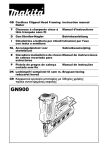
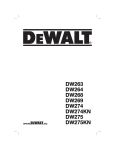
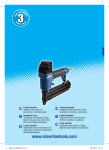
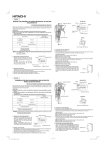
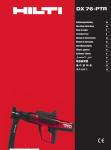
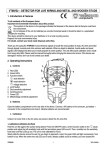
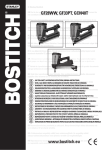
![Stiftnagler SK 335- 201 C deutsch [1] Abmessungen:L = 254](http://vs1.manualzilla.com/store/data/006281873_1-8c943fec4e20e2e88c178e3bef799b9c-150x150.png)
